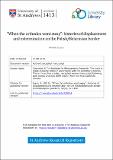Files in this item
"When the orthodox went away" : histories of displacement and extermination on the Polish/Belarusian border
Item metadata
| dc.contributor.author | Joyce, Aimée | |
| dc.date.accessioned | 2019-07-25T14:30:05Z | |
| dc.date.available | 2019-07-25T14:30:05Z | |
| dc.date.issued | 2019-07-15 | |
| dc.identifier | 253037393 | |
| dc.identifier | ff2aa11e-9233-4d6e-b3ec-d5fdf70f1904 | |
| dc.identifier | 85071767934 | |
| dc.identifier | 000472591700005 | |
| dc.identifier.citation | Joyce , A 2019 , ' "When the orthodox went away" : histories of displacement and extermination on the Polish/Belarusian border ' , Anthropological Quarterly , vol. 92 , no. 2 , pp. 427-450 . https://doi.org/10.1353/anq.2019.0021 | en |
| dc.identifier.issn | 0003-5491 | |
| dc.identifier.other | ORCID: /0000-0002-9041-4826/work/81798012 | |
| dc.identifier.uri | https://hdl.handle.net/10023/18166 | |
| dc.description.abstract | This article asserts that the current rise of right wing nationalism in Poland utilizes a set of nested historical erasures and silences. As Trouillot demonstrates, all history making is about selective acts of remembering and forgetting, and close attention to specific “unthinkable” histories reveals how power infuses the process of history making (1995:29). In the Polish case, the authorized historical record produces a homogeneous model of Polish identity by excluding specific histories of dispossession and destruction. Here, I focus on two places that relate to the horrors of Operation Vistula and the Holocaust. I begin by introducing these two silent spaces which trouble a small town on the eastern Polish border. The article moves first to explore how local people engage and evoke these silent spirits via the fragmented and intricate materiality of these haunted spaces and through acts of remembrance and forgetting. I argue that these practices are an attempt to negotiate a complex multi-ethnic history of conflict and cohesion. Yet they also reveal that some conflicts are more unsayable than others. Finally, the article demonstrates the different qualities of silence around these two historical atrocities. It draws on this difference to understand how local memory interacts with, and is undermined by, the historical narrative espoused by the current government. | |
| dc.format.extent | 765620 | |
| dc.language.iso | eng | |
| dc.relation.ispartof | Anthropological Quarterly | en |
| dc.subject | Poland | en |
| dc.subject | Silence | en |
| dc.subject | Affective space | en |
| dc.subject | Materiality | en |
| dc.subject | The Holocaust | en |
| dc.subject | Operation Vistula | en |
| dc.subject | GN Anthropology | en |
| dc.subject | T-NDAS | en |
| dc.subject | BDC | en |
| dc.subject | R2C | en |
| dc.subject.lcc | GN | en |
| dc.title | "When the orthodox went away" : histories of displacement and extermination on the Polish/Belarusian border | en |
| dc.type | Journal article | en |
| dc.contributor.institution | University of St Andrews. Social Anthropology | en |
| dc.contributor.institution | University of St Andrews. Centre for Contemporary Art | en |
| dc.identifier.doi | 10.1353/anq.2019.0021 | |
| dc.description.status | Peer reviewed | en |
| dc.identifier.url | https://muse.jhu.edu/article/729304 | en |
This item appears in the following Collection(s)
Items in the St Andrews Research Repository are protected by copyright, with all rights reserved, unless otherwise indicated.

